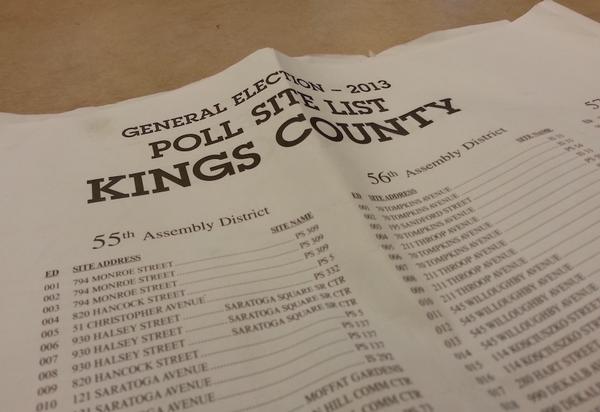
Photo by: Murphy
Lateef Olajide did not vote four times on Tuesday. It just felt like he did.
By the time Olajide made it to PS/IS 284 on Watkins Street in Brownsville a little after noon, he had already been to three other places, starting with his usual polling place at a public school on Bristol Street.
But that’s not a polling place anymore, so he was sent down to the public pool a half-mile away, only be redirected twice more to Watkins Street—where, ultimately, he had to fill out an affidavit ballot. “Running around is not good,” he steamed, worrying aloud about whether his wife, who gets home late from work, would have time to find their new site and vote. Olajide insists he received no notice of this change. “Nothing his time around,” he said. “It’s like they’re playing a trick.”
Olajide’s frustration—and his suspicion that the difficulties he was having were no accident—were common among voters in Brownsville on Tuesday.
The Board of Elections changed the site of 145 election districts for the November vote. It appears the change took effect only after the primary election, meaning people who voted then now need to vote in a different place.
The changes affected two districts in Queens, 18 in Manhattan and 125 in Brooklyn. No sites in Staten Island or the Bronx were affected.
At the Tilden Community Center on Mother Gaston Boulevard, Ms. Turner, the poll coordinator, said the voter confusion was nothing new. “We’re always going to get that because they do it at the last minute and don’t inform the voters,” she said. Turner said the local Democratic district leaders should have done more to get voters informed.
Many frustrated voters believed the problems were caused deliberately.
“I vote every time,” said a fuming Ernestine Jackson, at P.S. 284 trying to find where she was supposed to vote. “I am angry. I’m going to write a letter.”
“It was on purpose,” she said when asked about whether it was perhaps an honest mistake. “They don’t want Bill de Blasio to win. Republicans are doing everything in their power to keep de Blasio from winning.”
At the Van Dyke II senior center, which hosted lost two of its five election districts to the change, site coordinator Faith Footman worried that seniors would give up on voting when confronted with a need to walk several blocks to cast a ballot.
At the Betsy Head pool, worker Norman Frazier lamented the effect the late change would have on voters who bother to come out. After all, many don’t. “I live at Marcus Garvey. We have 630 units, and people just can’t be bothered,” he said, as an irritated-looking voter waving a referral slip from another polling site passed by.
“I can’t put my finger on [the motive],” he said of the poll-site switches.
But Carrie Harris, a 23-year veteran of poll working who uses a walker to get around, dismissed the idea that a walk of a few blocks was an excuse for not voting, or that any failures by the Board of Elections were to blame.
“They didn’t need to info you” about your polling place, she said. “It’s your duty to know!”







